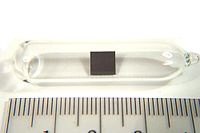
Photo from wikipedia
Abstract In this work, strontium vanadate glasses with the nominal composition (V2O5)60+ (SrO)40-x+(PbO)x (where, x = 0, 5, 10, 20, 30 and 40) were fabricated and their optical, structural, physical and nuclear… Click to show full abstract
Abstract In this work, strontium vanadate glasses with the nominal composition (V2O5)60+ (SrO)40-x+(PbO)x (where, x = 0, 5, 10, 20, 30 and 40) were fabricated and their optical, structural, physical and nuclear radiation shielding qualities were examined. Amorphous structures of the vanadate glasses were demonstrated by XRD analysis. With the insertion of PbO into the glasses, the density of the glasses was raised from 3.455 to 4.581 g/cm3, while molar volumes were reduced from 43.57 to 43.27 cm3/mol. It was found that as the addition of PbO is enhanced, the optical band gap energy is declined in the range of 3.96–3.55 eV. The UV- absorption spectra of the strontium vanadate glasses containing PbO were recorded in the wavelength range 200–1100 nm. The refractive indices of the VSP glasses proved that the proposed glass system can be considered as promising materials for photoelectronic and optical filter devices. Finally, nuclear radiation shielding attributes of strontium vanadate glasses with lead oxide additive were determined for gamma photons and fast neutrons. The mass attenuation coefficients (μ/ρ) were obtained working WinXCOM data. With PbO content progressive rising from 0 to 40 wt%, the μ/ρ values were increased. Then other related parameters such as HVL, Zeq, EABF and EBF for gamma-ray shielding were found. With PbO added content instead of SrO, the Zeq values increased while HVL, EBF, and EABF values reduced. In addition, since the addition of PbO was enhanced the density, the capacity of VSP glasses to retain fast neutrons was also increased.
Journal Title: Journal of Non-crystalline Solids
Year Published: 2020
Link to full text (if available)
Share on Social Media: Sign Up to like & get
recommendations!